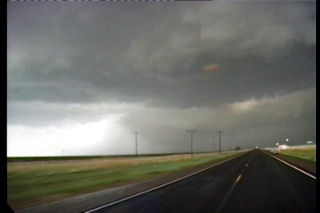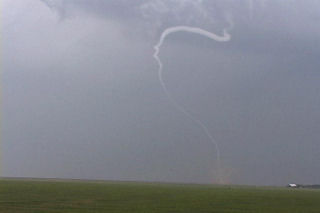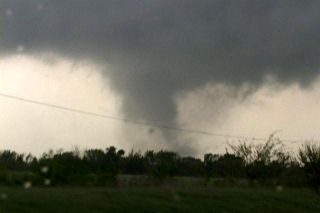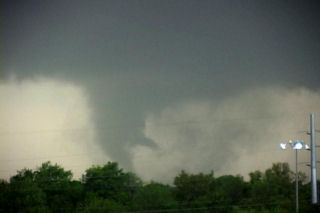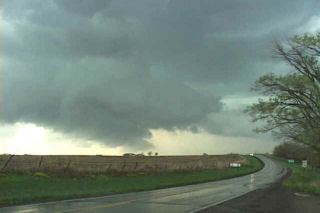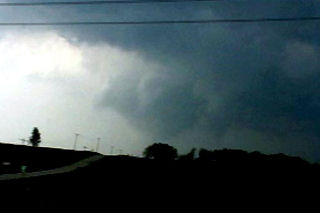This day had tornado outbreak written all over it. An intense upper level low was moving across southern Colorado and northern New Mexico headed for the Texas and Oklahoma panhandles. Deep tropical moisture was streaming northward with strongly backed surface winds across that region. By mid afternoon storms developed across northeast New Mexico and quickly became severe. Soon other storm developed across the north Texas and Oklahoma panhandles and quickly became supercellular and produced numerous tornadoes. I tool the SLT group to this area and we managed to intercept a rapidly developing supercell south of Boise City, Oklahoma by mid afternoon. This storm produced a beautiful white lit tornado as is narrowly missed Boise City by less than a mile. Soon we were vectored on to another supercell farther southeast by Dave Gold. This supercell also produced a tornado nears Griggs, Oklahoma. By late afternoon another tornadic supercell developed northwest of Stratford, Texas and produced two very large tornadoes. Finally near dark a last supercell developed east of Dumas, Texas and become a tornado monster. Many, many photos of these storms and their tornadoes as shown below.
May 4th, 2003 Pierce City, MO Long-tracked Tornado
Unbelievable day in the southeastern plains today! We began the day in OKC, determined to consider playing the tail end of this system. My concern (in addition to storm motion) was that the best show might occur in a narrow and early window over SC-E Nebraska (16-19Z) and then it would be over. Upon waking and looking at the data, it became apparent that the setup was indeed outbreak-like and that therefore one could likely pick about any storm and expect to see large tornadoes. Analysis soon suggested that the cap would break explosively in the HCRs ( horizontal convective rolls – bands of congested cumulus from which the most important storms of the day often develop; these bands are generally oriented along the low-level shear vector ) embedded within the highly unstable, strongly sheared warm sector. Stopping in El Dorado for fuel we watched as our surface winds slowly veered and our dewpoint spiked lower. Surface analysis revealed an intense low-level dry punch surging inexorably eastward towards SE KS and NE OK. I couldn’t believe it when I downloaded the SPC STOR and saw the 8-11 values blanketing the entire risk area from SE NE to N TX.
We decided on the spot to target SE KS, first intercepting storms on the northern portion of the E KS theta-e tongue and then dropping southward on different storms. We drove east on Hwy 54 to Iola and then north on 169 to Welda, KS where we sat for close to an hour watching convective towers get shredded to bits. Radar downloads revealed an intensifying cell moving NE towards the area south of CNU; rather than jumping on that as soon as we saw the first reflectivity core in NE Osage County, Oklahoma we sat watching convective towers closer to us. However, as the cell slowly matured and moved into Chautauqa Co. (see the radar downloaded via cell phone at the time, shown in Fig. 6 below), we could no longer sit still as we became convinced that this storm would become a prolific tornado producer. Driving south and then navigating around the NE side of CNU, we dropped SE in a desperate attempt to get ahead of this incredible storm (radar shot at the time, Fig. 7). As we passed the junction of Hwy 57/59 driving south on Hwy 59, we drooled at the spectacle of the rock hard convective bomb to our ESE. Following the western edge of the updraft down to cloud base, we immediately spotted a classic stovepipe tornado spewing debris about 7-8 miles to our E, somewhere near or just east of the Neosho wildlife area. Cursing at our failure to jump right on this storm as quickly as we noticed it on radar, we drove east on 160 out of Parsons, quickly taking up the rear of a very long and very sloooow moving caravan of storm chasers. We busted north and east on Hwy 126 intending to eventually intercept the classic tornadic supercell east of Girard, KS at or near the MO border. I gasped at the radar depiction of the storm’s hook overtaking Girard and wondered what kind of devastation was in store for towns east of this storm.
We were making great time and might have actually outflanked the storm as planned. However, fresh radar downloads revealed a very good looking tail end storm in Nowata Co. OK and we became convinced that this storm would eventually go on to produce significant tornadoes provided the dreaded 80-mph left mover to its SSE didn’t interfere too badly (this bit of bad luck killed what might have been a strong tornadic storm the day before near Childress, TX). On the way south to intercept the OK storm, we quickly detoured to check out the updraft base of another supercell moving NE through Labette Co., KS and quickly spotted a truncated cone tornado emanating from cloud base to our distant west. The storm started to look a bit more organized shortly afterwards and we pressed south, worrying that the Labette Co. storm would be interfered with by the tail end Charlie and would too seriously detract us from intercepting the southern storm. Driving through scattered golf ball -sized hail in the FF core, we observed the updraft (completely separated from FF core) and immediately noticed a fat, nubby funnel cloud just NE of Fairland, OK (we later learned that this was a weak tornado but couldn’t see the ground-based circulation for all of the trees and hills). Soon thereafter, the storm became rather disorganized as it merged with the left mover. Nonetheless, we persisted chasing this storm noting that inflow was still quite strong and moist southeast of the RF gust front . The storm began to intensify and take on scary HP/classic hybrid characteristics east of Neosho (which was devastated by a tornado on 4/24/75). Racing east on Hwy 86, we attempted to get to Hwy 60 north of Newtonia but the storm’s horrendous looking rear-flank core soon overtook the road before we got there and, fearing very large hail and powerful winds, we turned around and continued E and SE on Hwy 86, eventually turning north on Hwy 37 at the town of Purdy.
All this time, we were experiencing the storm’s ambient inflow which was 76/66 on 1725 winds. A new radar download revealed that this storm had retained classic supercell character with a vengeance and we wasted no time at all getting north to Monett , MO. The clefted -out barrel-shaped meso of an incredible beefy tornadic storm revealed itself to us soon after turning north out of Purdy and, 1 mile south of Monett , we observed a very large strong/violent tornado just northeast of town. We turned east on 60 and for the next 35-40 minutes experienced one of the most thrilling and fascinating tornadic experiences I’ve had. We watched in amazement as this fat, inky black-blue tornado rampaged across the countryside between Monett and Verona, spewing huge plumes of dirt/debris skyward. The tornado morphed into a fabulously fluid and dynamic multiple vortex tornado with evolutions that are best viewed on video rather than described. We got closer and closer to this high-contrast, long-lived tornado, watching as it lofted debris into cloud base and fearing for all in its path. I relayed reports to people with access to NWS numbers the best I could. I fear the tornado hit the north side of Aurora, MO. At times we got as close as 2/3 of a mile from the tornado as we drove northeast on Hwy 60 and then east on farm road 2200 south of Marionville and then Hwy 173 east of town. We got farther south of the tornado than we would have liked by this time (after being so close for so very long) but we got view of it again beneath the center of the incredible ground-dragging, clefted mesocyclone SW of Springfield: now it was an intense looking high-contrast stovepipe tornado with a fan-shaped debris cloud near Battlefield, MO. We watched as the tornado endured a classic rope-out on the west side of SGF, sparing the fortunate citizens of that city a bad tornado disaster.
April 30th, 2003 Northwest Missouri Supercell & Funnel
OKC at 7:30, we made our way to Topeka, KS. My optimism regarding the potential for visible tornadoes had evaporated the evening before due to the upper-tropospheric wave responsible for surface cyclogenesis being progged to fill/weaken rapidly due to stretching deformation (a tendency apparently underestimated rather badly by most models 2-3 days prior to the event). Nonetheless, we were optimistic about the likelihood of HP supercell thunderstorms initiating along the frontal boundary from NE KS to S IA/N MO. The focus of our afternoon data analysis was on finding the likely initiation point and best environment for daytime supercells; NE KS to S IA is an unacceptably large target area when storm motion vectors are going to be 35-40 kt. We became convinced that initiation would be near Falls City, NE with rapid intensification and maturation of supercells across extreme NW MO. Our mistake was that we didn’t have enough confidence in this to set up shop downstream of the expected initiation point – there have been many times when I overshoot the area of initiation and have to backtrack westward.
We moved north from TOP on Hwy 75 at about 4pm CDT, observing congested (albeit mushy) CU and TCU to our NW through E. At the Hwy 36 junction we observed glaciated convective towers to our not too distant N and NNE; additionally, the developing congestus N through NW was being visibly undercut by scud apparently associated with the leading edge of the cold front, so we continued on eventually crossing into MO east of Falls City. When we turned north on Hwy 59 in east-central Holt county we could make out much cloud base structure associated with our target supercell. We observed a well-defined dry slot with developing RFD gust front; to the NE of that was a very ominous block-shaped lowering/wall cloud that definitely had a tornadic appearance. We were too far to discern any detail. We continued stair-stepping N and E and when we were just east of Maitland on CR A we observed a fully occluded wall cloud with truncated cone shaped funnel cloud about 4-5 miles NNW of our location; the wall cloud and accessory scud tags were wildly rotating and I estimate its location to have been close to the town of Skidmore; I don’t remember the exact time (too busy navigating to keep a log) but it was probably around 6-6:15pm and we were too distant to confirm/deny that the funnel cloud was actually a tornado. I would not be surprised if a large tornado occurred somewhere N or W of Skidmore.
Unfortunately, we had been effectively outflanked by the storm so could not achieve the desired position due E or ENE of the meso. New mesocyclogenesis was rapidly underway to our immediate ENE and the RFD gust front was loaded with vorticity and wild, fluid vertical motion. Soon thereafter, the storm tended more to HP characteristics and developed a menacing rear-flank core with encircling shelf cloud. However, it refused to give up on trying to develop a forward flank updraft/meso as inflow stratus continued to fly into the storm from the E and SE and scud rose and attached to cloud base at the E edge of the core. East of Conception Junction in eastern Nodaway County we were briefly overtaken by the southern edge of a tightly circular precip curtain, the apparent center of low-level circulation passing just to our north. Our winds turned from SSE to W, gusting to near 50 kt. We finally got to the junction of US Hwy 169 and CR O at Gentry. The storm was now decidedly HP in character with a substantial surging RFD core/gust front bearing down on us from the SW and a less menacing FF core to the NW; we were sitting in the notch at this crucial intersection with no more east option. To our immediate SW and almost overhead a patch of cloud base was swirling wildly as the RFD core pivoted around from the W and SW to overtake us.
The rotating cloud base moved quickly to our east across open pastures near Gentry, MO and we were forced north into the SW edge of the FF core, letting the more dangerous RFD core pass to our SE. After the maelstrom passed we once again attempted to outflank the storm but decided to blow it off at I-35 in favor of targeting a more isolated storm SE of STJ. Downloading radar as we drove (my goodness gracious, I never failed to get a wonderful cell phone connection yesterday), we headed directly to I-35 exit 40 at Lathrop. Too late (we heard the warming for the spotter-indicated tornado near Edgerton); it was an interesting looking soda can LP storm (we got 1″ diameter in the vault and cars were briefly blocking the interstate at an underpass) with an amusing array of sheriff deputies and other gawkers staring up at the sky. On the way south, we were mightily distracted by a ridiculously explosive convective bomb forming over STJ. As we drove south on the interstate we watched as the fat convective tower expanded, grew, overturned and went crazy. We turned around at Lathrop and stopped west of Cameron on Hwy 36 for a very entertaining lightning show (great anvil crawlers in the vault/overhead anvil). Stayed around until the storm lost supercellular characteristics and lined out.



